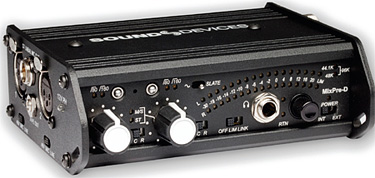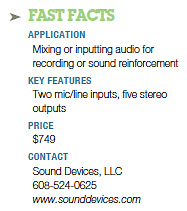Sound Devices MixPre-D Mixer

Sound Devices MixPre-D audio mixer
In the field, in the studio or in post, there are times when you don't need, or don't want, a big audio mixer. Maybe you'll only be working with a mono or stereo source, but you want something better than camera microphone inputs. In some cases, the devices you're asked to feed have no reliable balanced analog audio inputs (I'm thinking of computers, iPhones, iPod Touch or iPads).
FEATURES
If you find yourself in such a situation often enough to want do something about it, try the Sound Devices MixPre-D (D for digital). It's similar to the analog MixPre, as they share a nearly identical front end. However, the MixPre-D has 24-bit AES3 and USB outputs. There are some other differences too: no input peak lights on the MixPre-D, and many of the dedicated external switches on the Mix-Pre have been internalized on the MixPre-D, requiring "hold this, slide or twist that" operation of the remaining buttons, knobs and switches.
For example, to switch sample rates, you'll need to hold down the headphone level control and switch the left XLR output switch to the AES position. Not a deal killer, but you'll certainly want to acquaint yourself with the operations manual. Fortunately, Sound Devices has printed the info on the MixPre-D bottom panel. Also, you do need to be a little careful about grabbing the MixPre-D, as you can inadvertently hit a button that does something you don't want it to do at that moment.
On the input side, the two 2,000 Ohm impedance XLR analog mic/line inputs are transformer balanced with 66 dB of gain and a very quiet −128 dBu EIN. Line input impedance is rated at 16,000 Ohms. Input clipping of the mic circuit doesn't happen until −10 dBu and +28 dBu for line inputs. The common mode rejection ratio is 100 dB at 80 Hz, 60 dB minimum at 10 kHz. Frequency response is 20 Hz to 30 kHz, within +0.2 dB and −0.5 dB.
Need more than two inputs? If you don't need stereo headphone return monitoring, each channel of the Tape Return input can be independently routed to the left, center or right output busses. Those sources need to be −10 or line level and adjustable, as the Tape Return input has no mic preamps. Input levels for inputs 3 and 4 are controlled by pressing input 1 and input 2 buttons and turning the headphone control.
The MixPre-D's has five different stereo outputs; an active-balanced mic/line via two XLRs, an unbalanced, fixed 200 Ohm mic level via TA3M for DSLR cameras (−36 dBu), an unbalanced, fixed 2,000 Ohm tape output via 1/8-inch TRS, a 24-bit AES3 XLR and a 24-bit USB (cable included).
The MixPre-D's 24-bit A/D converters operate at 44.1 kHz, 48 kHz, or 96 kHz, and can be switched at the mixer or from the Apple Audio/MIDI Setup panel after connecting to a Mac. When I connected to my Mac via USB, the MixPre-D automatically detected that the Apple Audio/MIDI panel was set to 48 kHz and switched to 48 kHz. The USB interface works with Apple 10.4+, Windows Vista, Windows 7 (32- and 64-bit) or Linux.
There's a two-way switch on the MixPre-D left XLR output for mic/line switching. The right XLR output has a three-way switch for mic, line and AES3.
In AES3 mode, the left XLR output continues to pass analog audio as long as either of the inputs is panned to left or center. When using the AES3 mode, the right XLR passes signal from both inputs regardless of panning. So you can have simultaneous analog and digital outputs, but the analog XLR output will not be in stereo.
You can still get stereo analog out via the unbalanced Mic and Tape level outputs. Both left and right USB output also remain active in AES3 output mode. Remember to turn down any input pot not being used to keep the unterminated XLR noise from getting to the outputs.
The MixPre-D supports X/Y and M/S stereo linking, and in those modes the high pass filters and limiters continue to work. In X/Y, the channel 2 pot controls both preamp levels. You can also reassign the inputs to different or both outputs with the output pan switches. During M/S operation, with the mid mic in input 1 and the bi-directional mic in input 2, input 1 controls the spread and input 2 controls the overall gain.
The input and output limiters have an adjustable threshold from +6 dBu to +18 dBu. The ratio is fixed at 20:1. The attack time is set at 1 msec with a 500 msec release time. That's fast enough for most program material, but sound with very quick transients, such as handclaps, may sneak though. The limiters can be set to work jointly as a stereo limiter, or independently, which you might want to do with a different wireless mic feeding each input.
The Mix-Pre-D runs on two AA batteries for about four hours if phantom power is used, but you can also run it from a 10 to 18 V DC external supply. Sound Devices also sells a suitable AC to DC power supply, the XL-WPH3. (It has an internal poly fuse to protect the mixer and resets itself automatically after an offending power source is used and removed. ) You can toggle between internal and external power without interrupting signal flow. When the power drops below a certain level, the green power light flashes.
A slate mic and built-in 1 kHz tone oscillator round out the package. When slate mic or tone is activated, program is muted. Tone is sent to all outputs. The main metering doesn't have all of the options on larger format Sound Devices mixers, but VU plus peak works fine for me, and the brightness can be adjusted.
IN USE
During its stay here, I used the MixPre-D to feed analog camera inputs, Garage Band, Adobe Audition CS5.5 on my Mac via USB and from the AES3 output to my Pro Tools Digi 003R. I used a Graham-Patten Systems baluns at the AES output of the MixPre-D and fed the Digi 003R via the S/PDIF input.
Although voice recordings were accomplished without incident, when I engaged the tone on the MixPre-D I heard a cyclical ticking within the tone at the Digi 003R. It turned out to be a clock disagreement. As soon as I changed the Digi 003R clock source from my external RME A/D converter to the S/PDIF input, everything was fine.
As far as powering the unit, I had two power-hungry Schoeps mics attached and kept the headphones turned up fairly high. Eventually I noticed that the flashing light warning indicator said it was time to replace the batteries. However, the power supply kept on going without any motorboating.
SUMMARY
The MixPre-D appears to be another piece of good gear in the consistent Sound Devices line. I would have liked more dedicated controls so that I didn't have to use various secret handshakes to change settings; however, the unit works very well. The Sound Devices limiters are nicely set for most program material. If your present chain doesn't have a good set of stereo limiters, consider using the MixPre-D just for its limiters before your final record destination or public address feed. Last, but not least, I need to note that Sound Devices offers a very handy XL-CAM accessory mount that allows the MixPre-D to be securely mounted to the bottom of DSLR cameras. There's also a standard threaded hole on its bottom plate to provide different mounting options. Sound Devices also offers a variety of interconnect cables and external powering solutions.
Ty Ford has been reviewing pro audio gear for more than 20 years. He may be contacted at tyford@mac.com.

Get the TV Tech Newsletter
The professional video industry's #1 source for news, trends and product and tech information. Sign up below.
